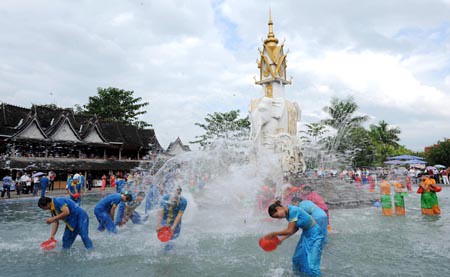Shibao (Treasured Stone) Stockade
Shibao (Treasured Stone) Stockade, which lies on the northern bank of the Yangtze River 45 km east of the Zhongxian County seat, Chongqing City, is built on the side of Yuyin (Jade Seal) Mountain facing the river. Rising abruptly, the isolated peak looks like a jade seal, hence the name. Legend has it that it was a stone left by Nu Wa (a goddess in Chinese mythology) when repairing damage to
Suzhou Gardens
Suzhou is famous for its classical gardens, which merge the beauty of the nature, architecture and painting. Rocks, flowers and trees are cleverly interspersed among pavilions, terraces, open halls, winding paths and corridors. Gardens open to the public include the Blue-Wave Pavilion of the Song Dynasty, the Lion-Grove Garden of the Yuan Dynasty, the Humble Administrator's Garden, Linger-Here
The Qiao Courtyard
A visit to the Qiao Courtyard in Qiaojiabao Village near Taiyuan City, capital of Shanxi Province, will get you acquainted with the local customs and practices of the central Shanxi area during the late Qing Dynasty and the initial period of the Republic of China (1912-1949). The courtyard, built during the Jiaqing and Daoguang reign periods of the Qing Dynasty, includes six large compounds, 20
Ancient Street of Tunxi
This street, paved with flagstones, in Tunxi City, Anhui Province, is about 1,000 m long. Old-style buildings with two stories line the street. They have white walls, black tiled roofs and horse-head-shaped eaves. The street recreates the style of the Southern Song Dynasty, hence the name of the "Song Street," or "Song City." Foreign tourists call it the "Ancient Rome of the East."
Sunken Courtyard Dwellings
Sunken Courtyard Dwellings This unique form of dwelling is found on the loess plateau in Pinglu County, Shanxi Province. It is formed by digging a pit, 10 m deep, and hollowing out caves in the walls to serve as living quarters for both men and animals. The entrance and exit is via a slope. They show a unique style.
Sanxingdui
Sanxingdui, located in the suburbs of Guanghan City, Sichuan Province, is famous for the 5,000-year-old ruins of the capital of the Kingdom of Shu, pushing back the history of Shu by 2,000 years. A large number of unearthed cultural relics prove that Sanxingdui was one of the five major trade centers in ancient China. Bronze objects excavated here include the statue of man bigger than life
Leshan Giant Buddha
The Leshan Giant Buddha is located on the west slope of Mount Lingyun, on the eastern bank of the Minjiang River near Leshan City, Sichuan Province. At 70.7 m high and 24 m wide at the shoulders, it is the biggest Buddha statue in China. The project started in the first year (713) of the Kaiyuan reign period of Emperor Xuanzong of the Tang Dynasty and was finished in the 19th year (803) of the
Terracotta Warriors and Horses of the Qin Dynasty
The terracotta warriors and horses were found 40 km east of Van City, Shaanxi Province. They were buried in a series of pits to guard the mausoleum of the First Emperor of the Qin Dynasty, China's first unifier. The three pits so far excavated are 1.5 km from the tomb. The first pit has over 6,000 life-size terracotta warriors and horses, arranged in 38 rows of troops; the second pit has more
God Hill Cliff Paintings
About two km north of Daligaigou in the Urad Rear Banner of Inner Mongolia, there stands a steep hill with a flat top. The locals regard it as a sacred spot, hence the name "God Hill." On the northern slope of the hill, there are many jagged rocks with grotesque shapes which bear ancient cliff paintings of animals, horse riders, carriages, dances and a star map.
Yin Mountains Cliff Paintings
These cliff paintings are located in western Inner Mongolia. They can be divided into four types: the oldest ones dated from the New Stone Age to the Bronze Age, or the period of the Xia, Shang and Zhou dynasties of the Central Plains; the second-oldest were executed by the Xiongnu nomads at a time equal to the period of the Eastern Zhou Dynasty to the Western Han Dynasty; the third-oldest
Total: 151 Items This is 13 Page( 10 Items/Page) Result Page: 16 Pages First Previous Next LastArt
 more
moreIrving dual-language students
Melissa Reyna (center) and Johanna Sanchez

Dev, Denny to quizz for charity
Director Danny Boyle (R) holds his Oscar for

Beijing, Taipei team up for
The Palace Museum in Beijing and the Palace

Premier reassures university
story:·Wen has pledged the government would "put the issue

Custom
 more
moreProvinces Site
Chinese Medicine
 more
more









